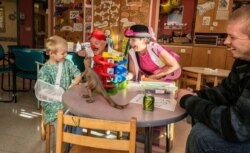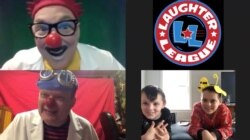Jay Stewart spends a whole lot of time wearing a red clown nose.
He has taught at the Ringling Brothers and Barnum & Bailey Circus Clown College and served as head of the circus’s clown squad for several tours. He has performed in Japan’s Kinoshita Circus, along with his wife, Kristen, who is also a clown. He has taught clowning at camps and holiday resorts.
Sans nose, he has played Moe Howard in a Three Stooges tribute show in Las Vegas. Currently, he works gig-to-gig teaching, directing and performing near his home base of Cape Cod, Massachusetts.
But his most important gigs these days are private shows – an audience of one at a time.
Stewart is part of the Laughter League, a team of professional clowns who make daily rounds at Boston Children’s Hospital, the pediatric teaching hospital for Harvard University and one of the top children’s hospitals in the United States.
“That nose that I wear, and that most of our team wears, that’s a promise that we make to those kids,” he said. “We’re not coming to draw blood or anything ... We’re coming in to encounter them face-to-face, nose-to-nose, on the same level.”
Stewart, whose clown character is a bumbling handyman named Doc Skeeter, has been making rounds with the other clown docs – Dr. Slappy, Dr. Monday, Dr. Yahoo, and Dr. Bullfrog among them – for about 12 years. With social distancing, they’ve had to come up with a new way of visiting their “patients” – by Zoom video chat. They call the program Nose-to-Nose.
At first, Stewart was skeptical about the format.
“My initial thought was, ‘It’s going to take away so much of what we do,” he said. “The immediacy, the presence.” He found, however, that he liked “being a human cartoon.” He said being onscreen gave him some advantages – like placing props or sound effects out of sight of the camera for a surprise gag.
Beth Donegan Driscoll, director of child life at Boston Children’s Hospital, said Nose-to-Nose has enhanced the clowns’ work by making them accessible to more patients. Now the clowns can reach patients at offsite locations who hadn’t had access to them before. Even patients whose environments must be carefully protected can now get some clown time – or, as Driscoll described it, “that joyful, magical experience.”
Driscoll is sensitive to the needs of the patients and their families. Her job is to ease the emotional ordeal of medical treatment for her young clients.
“Coming to the hospital can bring about feelings of anxiety, feelings of isolation, of fear,” she said. “When the clowns are with the kids and the family and the staff, those feelings seem to disappear. You can see it in the face of the child. You can see it in the faces of the family.”
Stewart said the hospital visits present a more complex challenge than playing to a crowd. The clowns conduct their rounds in teams of two, so they can play off each other in what is, by nature, an improvised performance. But it’s the child who’s in charge.
“In a medical setting, that kid doesn’t get to say no to anything,” Stewart said. “He can’t say, ‘No, you can’t take blood.’ ... What we try to do is empower the kid.” His alter ego, Doc Skeeter, makes goofy mistakes and asks for advice, putting the patient in charge of the show.
Stewart explained the approach: “You walk into a door frame once, and there’s a laugh about it. And then as you start to do it again, the kid yells, ‘Watch out for the door!’ That kid is now helping direct where you’re going to go.” He continued the imaginary exchange: “’Oh, should I go this way?’ ‘Yeah, go that way!’ And you walk into the other side of the door frame.”
Like Driscoll, Stewart hopes the new video format can bring the clowns’ giddy magic to more young patients who otherwise would remain isolated.
“There’s a lot of medical trials and experimental stuff going on there at Children’s,” he said, meaning there are a lot of patients whose rooms are off-limits for clown visits. “But if they’re able to have an iPad in their room, we can still have a visit on video.” So maybe, he said, something good will come out of this pandemic after all.
The clowns’ virtual presence at the hospital is comforting for another reason, Driscoll said. The clowns are a vital part of the community in a place where stress, anxiety and fear are a constant presence.
“If you’re on a unit and you hear laughter,” Driscoll said, “you know the clowns are on that floor. They change the atmosphere, they really do. I’m talking about the nursing staff, the doctors, the parents, the receptionists, the administrative assistants. They’re here for everybody. And when they walk by, things kind of melt away and it’s just about fun and playfulness. And gosh, I don’t know who couldn’t use that.”
Stewart said that when the clowns enter the hospital, they interact with anyone who comes their way: patients, families, medical faculty, staff. He said sometimes it can take 20 minutes for two clowns just to make their way across the lobby.
But that’s intentional. He said the red clown nose is meant as a beacon. In his words, it says, “Here’s where we’re not gonna do medical stuff. Come over and play.”



